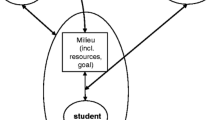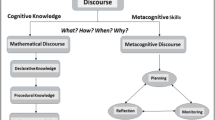Abstract
The purposes of this study were to understand the nature of discourse in terms of knowledge types and cognitive process, source of utterances (student or teacher), and time use in microcomputer-based labs (MBL) and verification type labs (VTL) and to gain an understanding of the role of MBL in promoting mathematization. The study was conducted in 2 grade 11 classes in which students studied Hooke’s law and Newton’s second law of motion using MBL during 1 year while a different group of students studied the same topics with the same physics teacher using a VTL approach. All sessions were videotaped, transcribed and coded using a taxonomy developed by DeVito & Grotzer (2005). In addition, evidence to support each of the 5 steps of mathematization was sought from the actions of the teachers and their discourse with the students. Results showed that conceptual knowledge type utterances were significantly more frequent in MBL sessions, cognitive processes of remembering and understanding were significantly more frequent in the MBL sessions, students spent most of their time analyzing the graphs in the MBL sessions, and MBL has a potential to promote mathematization in favorable instructional environments in physics laboratory classes.
Similar content being viewed by others
References
Anderson, L., & Krathwohl, D. (Eds.). (2001). A taxonomy for learning, teaching, and assessing: A revision of Bloom’s taxonomy of educational objectives. New York: Addison Wesley Longman, Inc.
Arcavi, A., & Hadas, N. (2000). Computer-mediated learning: An example of an approach. International Journal of Computers for Mathematical Learning, 5(1), 25–45.
Bisdikian, G., & Psillos, D. (2002). Enhancing the linking of theoretical knowledge to physical phenomena by real time graphing. In D. Psillos & H. Niedderer (Eds.), Teaching and learning in the science laboratory (pp. 193–204). Dordrecht: Kluwer Academic.
de Lange, J. (1987). Mathematics, insight and meaning. Utrecht, The Netherlands: Rijksuniversiteit Utrecht.
DeVito, B. & Grotzer, T. (2005). Characterizing discourse in two science classrooms by the cognitive processes demonstrated by students and teachers. Paper presented at the annual conference of the National Association for Research in Science Teaching (NARST), Dallas, TX, April.
Espinoza, F. (2006–2007). The use of graphical analysis with microcomputer-based laboratories to implement inquiry as the primary mode of learning science. Journal of Educational Technology Systems, 35(3), 315–335.
Freudenthal, H. (1991). Revisiting mathematics education. China lectures. Dordrecht, The Netherlands: Kluwer Academic.
Funkhouser, C. (2002). The effects of computer-augmented geometry instruction on student performance and attitudes. Journal of Research on Technology in Education, 35(2), 163–175.
Gillies, A., Sinclair, B., & Swithenby, S. (1996). Feeling physics: Computer packages for building concepts and understanding. Physics Education, 31, 362–368.
Hofstein, A., & Lunetta, N. (2004). The lab in science education: Foundations for the twenty-first century. Science Education, 88(1), 28–54.
Krathwohl, D. (2002). A revision of bloom’s taxonomy: An overview. Theory into Practice, 41(4), 212–218.
Krusberg, Z. (2007). Emerging technologies in physics education. Journal of Science Education and Technology, 16(5), 401–411.
McRobbie, C., & Thomas, G. (2000). Epistemological and contextual issues in the use of microcomputer-based laboratories in a year 11 chemistry classroom. Journal of Computers in Mathematics and Science Teaching, 19(2), 137–160.
Michelsen, C. (2005). Expanding the domain: Variables and functions in an interdisciplinary context between mathematics and physics. In A. Beckmann, C. Michelsen, & B. Sriraman (Eds.), Proceedings of the first international symposium of mathematics and its connection to the arts and sciences (pp. 201–214). Berlin, Germany: Verlag Franzbecker.
Niedderer, H., von Aufschnaiter, S., Tiberghien, A., Buty, C., Haller, K., Hucke, L., et al. (2002). Talking physics in labwork contexts—a category based analysis of videotapes. In D. Psillos & H. Niedderer (Eds.), Teaching and learning in the science laboratory (pp. 31–40). Dordrecht, The Netherlands: Kluwer Academic.
Niss, M. (1999). Aspects of the nature and state of research in mathematics education. Educational Studies in Mathematics, 40(1), 1–24.
Orfanos, S., & Dimitracopoulou, Α. (2003). Technology based modeling activities in learning concepts relations in kinematics. In A. M. Vilas, J. A. M. Gonzalez & J. M. Gonzalez (Eds.) Advances in technology-based education: Toward a knowledge-based society. II International conference on multimedia ICT’s in Education, Badajoz, Spain, Dec 3–6 2003, Edition: Junta de Extremadura, Consejeria de Education, Volumes: I–III, Collection.
PISA (2003). The PISA 2003 assessment framework—mathematics, reading, science and problem solving knowledge and skills. Paris: Organization for Economic Co-operation and Development (OECD).
Rochelle, J., Kaput, J., & Stroup, W. (2000). SimCalc: Accelerating students’ engagement with the mathematics of change. In M. J. Jacobson & R. B. Kozma (Eds.), Innovations in science and mathematics education: Advanced designs for technologies of learning (pp. 47–75). Mahwah:, NJ Erlbaum.
Russell, D., Lucas, K., & McRobbie, C. (2004). Role of the microcomputer-based laboratory display in supporting the construction of new understandings in thermal physics. Journal of Research in Science Teaching, 41(2), 165–185.
Scheker, H. (1998). Integration of experimentation and modeling by advanced educational technology: Examples from nuclear physics. In B. J. Fraser & K. J. Tobin (Eds.), International handbook of science education (pp. 383–398). Dordrecht, The Netherlands: Kluwer Academic.
Songer, N. B. (2007). Digital resources versus cognitive tools: A discussion of learning science with technology. In S. Abell & N. Lederman (Eds.), Handbook of research on science education (pp. 471–491). Mahwah, NJ: Erlbaum.
Thomas, G. (2001). Toward effective computer use in high school science education: Where to from here? Education and information Technologies, 6(1), 29–41.
Author information
Authors and Affiliations
Corresponding author
Rights and permissions
About this article
Cite this article
BouJaoude, S.B., Jurdak, M.E. INTEGRATING PHYSICS AND MATH THROUGH MICROCOMPUTER-BASED LABORATORIES (MBL): EFFECTS ON DISCOURSE TYPE, QUALITY, AND MATHEMATIZATION. Int J of Sci and Math Educ 8, 1019–1047 (2010). https://doi.org/10.1007/s10763-010-9219-2
Received:
Accepted:
Published:
Issue Date:
DOI: https://doi.org/10.1007/s10763-010-9219-2




